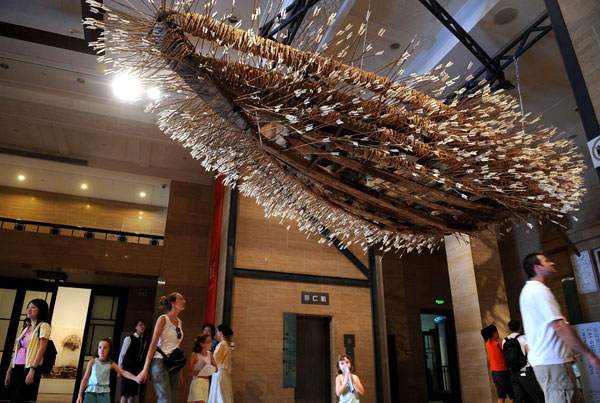"They traveled or moved to the West, seeking publication for their artworks inspired by Western art. This type of Chinese art is very close to Western art, so it's the easiest kind for our museum to bring into our collection," he says.
Cai Guoqiang, the artist behind the installation piece Borrowing Your Enemy's Arrows, which is the MoMA's first major Chinese contemporary art piece, was one of those artists who ventured out, moved to New York in 1995.
A giant boat, struck by 3,000 arrows, "floats" into the air in the exhibition hall. It has a strong visual impact and provokes the viewer to consider the "global" issue of cultural clash by "manipulating materials with skills similar to Western artists", Levenson says.
It's understandable for Western art museums to choose works and define modern and contemporary art based on Western values, says Lee Sook-kyung, a research curator from Tate Research Centre of Asia-Pacific in London.
She says she thinks art museums in China should encourage Chinese contemporary artists to showcase more individuality in their works rather than catering to Western tastes.
 |
| Cai Guoqiang's installation Borrowing Your Enemy's Arrows has been widely seen in the West. Jiang Hongjing / Xinhua |
"The art museums in China should keep improving themselves to become world-class. Artists will be confident to display their works in local museums if they can gain attention and influence that is equal to if they put on an exhibition in a Western museum," Lee says.
To share their experience of managing art museums and promoting Asian art, 82 directors and senior curators of museums from 30 countries and regions across Asia, Europe and the Americas gathered in Guangzhou, Guangdong province, in September, to take part in the first Asian Art Curators' Forum, co-organized by Guangdong Museum of Art and National Art Museum of China.
Participants came to a consensus that Asian art museums will share their online resources and jointly put on biennials to display their collections.
For Western guests like Levenson from the MoMA and Lee from the Tate, the forum offered a great opportunity to learn about Asian art and seek international cooperation.
"Chinese art should proactively venture out to promote itself overseas. For example, many art galleries in Latin America travel around the world to art fairs to display their local artworks," Levenson says.
Chinese artists could learn from the experience of some Asian countries.
The National Museum of Modern and Contemporary Art in South Korea has taken its touring exhibitions of Korean art across Asia, to North America, Europe and other regions.
The National Museum of the Philippines is planning to engage people living in the Filipino community in Chicago to host an exhibition on Philippine traditional art.
Jason Sun, a curator from the Department of Asian Art of the New York-based Metropolitan Museum of Art, hopes Chinese art museums can be more open-minded to collect Western artworks and enhance their cooperation with Western art museums.
"The communication between the Metropolitan and Chinese art museums over the past 30 years has been one-way: Metropolitan borrows relics from Chinese art museums to display to Western audiences," Sun says.
